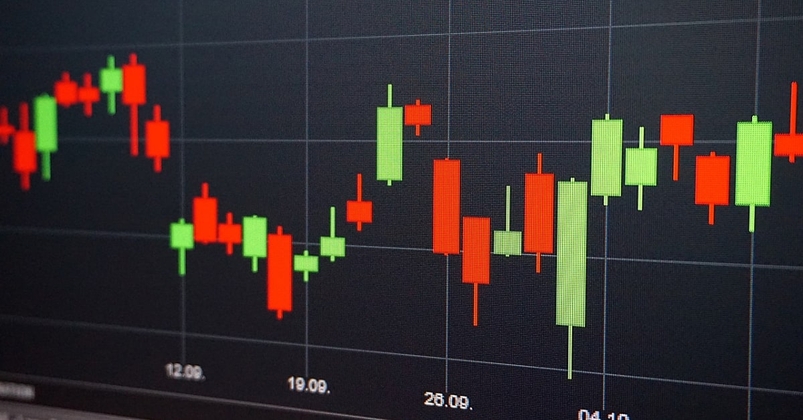CFD sind komplexe Instrumente und beinhalten wegen der Hebelwirkung ein hohes Risiko, schnell Geld zu verlieren.72.6% der Kleinanlegerkonten verlieren Geld beim CFD-Handel mit diesem Anbieter. Sie sollten überlegen, ob Sie verstehen, wie CFD funktionieren und ob Sie es sich leisten können, das hohe Risiko einzugehen, Ihr Geld zu verlieren.
Why this FOMC meeting could see significant volatility in markets

The aim of this is to proactively push inflation (in the US) above its long-held target of 2%. When above this threshold, inflation would then be tolerated on a sustained basis.
This is widely different from years gone by when the Fed would signal rate hikes were coming well before inflation hit 2%.
So, the Fed’s reaction function has essentially changed, which means they will be far slower to hike, even well into the future when the economy is growing above trend and the labour market is strong.
(White - the fed funds rate, pink - core inflation)
(Source: Bloomberg)
The Fed moving to AIT and letting the economy run hot is absolutely the right policy. But, if the Fed’s going to drive inflation to 2%, aside from base effects, we need to know how on earth they’re going to do this.
That’s why next Wednesday’s (Thursday 4am AEST) FOMC meeting is so undeniably critical. There could be fireworks in the market and our clients are getting ready to trade it.
Consider that aside from a brief period in 2006/07, the Fed is going to execute on something they have simply failed to do since 1995.
This is an institution that has failed miserably to meet its inflation forecasts time and time again.
It’s easy to be cynical, but if the Fed is to be seen as credible, gaining the market's respect is key above all else. So, we want answers and they need to come next week. Waiting just won't cut it.
So how do they do it?
The Fed needs to change behaviours: they need to convince the public that prices are going up. This isn’t just by pumping up financial markets and making credit/loan repayments insanely cheap. The public needs to believe everyday items that feed into the inflation calculation are going up. By altering the perception of future prices, it manifests into actual inflation.
This is incredibly difficult, but it’s the only way. Inflation expectations breed inflation. By lifting inflation expectations and putting in measures to keep bond yields anchored, ‘real’ bond yields will move even deeper into the negative, the USD will weaken and asset prices will push higher.
A weaker USD is critical in driving higher inflation. Although a one-way move in the USD will increase talk of currency wars and a race to the bottom, which is why gold is so attractive in this environment.
The Fed would dearly like more stimulus at a fiscal level, but that’s out of their hands. But if they’re going to gain the credibility they crave from the market, they simply must go sooner and bring out the big guns.
If they get it right? We’ll see equities and gold trade higher, with real Treasury yields and the USD lower.
However, if they don’t offer us clarity, urgency and a clear plan, the market will take its pound of flesh and the USD will rally.
If they’re going to do what they have failed to do for so many years, they simply need to make it happen next week and show the world they mean business. Credibility is everything.
Related articles
Bereit zu traden?
Es ist einfach, ein Pepperstone-Konto zu eröffnen. Stellen Sie Ihren Antrag innerhalb von Minuten, auch mit einer geringen Einzahlung. Beginnen Sie Ihre Reise mit Pepperstone noch heute.
Bei diesem Artikel handelt es sich um eine Werbemitteilung. Diese Information wurde von Pepperstone GmbH bereitgestellt. CFD sind komplexe Instrumente und beinhalten wegen der Hebelwirkung ein hohes Risiko, schnell Geld zu verlieren. Zwischen 74 % und 89 % der Kleinanlegerkonten verlieren beim Handel mit CFD Geld. Sie sollten überlegen, ob Sie verstehen, wie CFD funktionieren und ob Sie es sich leisten können, das hohe Risiko einzugehen, Ihr Geld zu verlieren. Zusätzlich zum untenstehenden Haftungsausschluss enthält das auf dieser Seite enthaltene Informationsmaterial weder eine Auflistung unserer Handelspreise noch ein Angebot oder eine Aufforderung zu einer Transaktion in ein Finanzinstrument. Pepperstone übernimmt keine Verantwortung für die Verwendung dieser Kommentare und die daraus resultierenden Folgen. Es wird keine Zusicherung oder Gewähr für die Richtigkeit oder Vollständigkeit dieser Informationen gegeben. Folglich trägt der Anleger alleinverantwortlich das Risiko für einzelne Anlageentscheidungen. Jede angebotene Studie berücksichtigt nicht das Investment spezifischer Ziele, die finanzielle Situation und die Bedürfnisse einer bestimmten Person, die sie empfangen kann. Sie wurde nicht in Übereinstimmung mit den gesetzlichen Vorschriften zur Erstellung von Finanzanalysen erstellt und gilt daher als Werbemitteilung im Sinne des Wertpapierhandelsgesetzes (WpHG).

